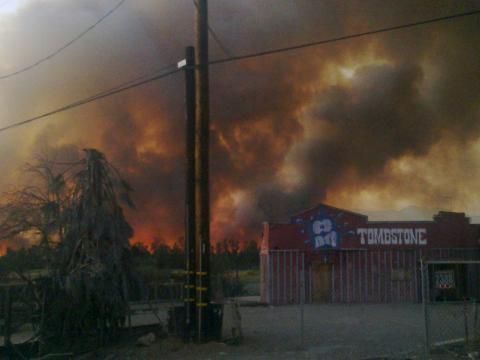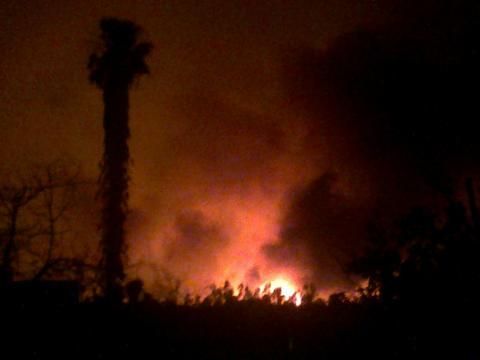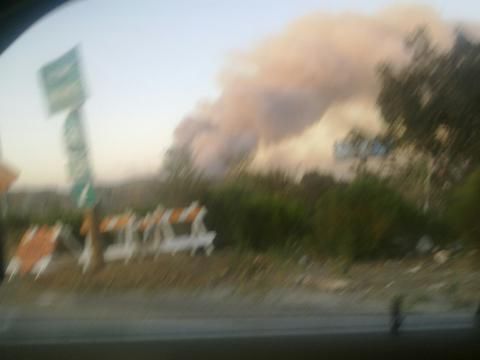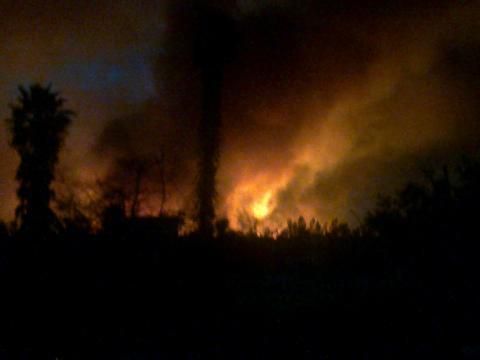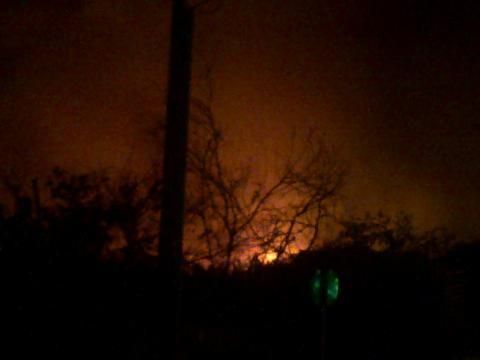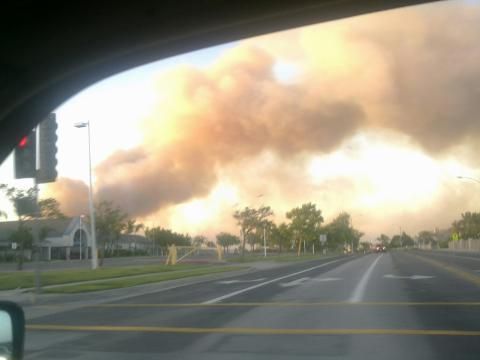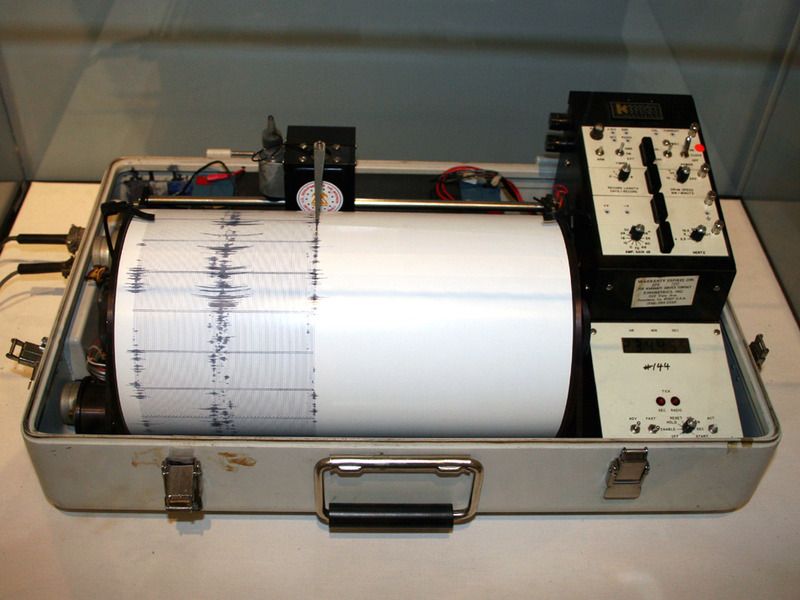FLORENCE AND NORMANDIE - On April 29, 1992, unfolded one the worst civil unrest in American history that spread well beyond the city of Los Angeles. As much of America looks onto what is unfolding in Baltimore it is important to look back on those very dark spring days in Southern California.
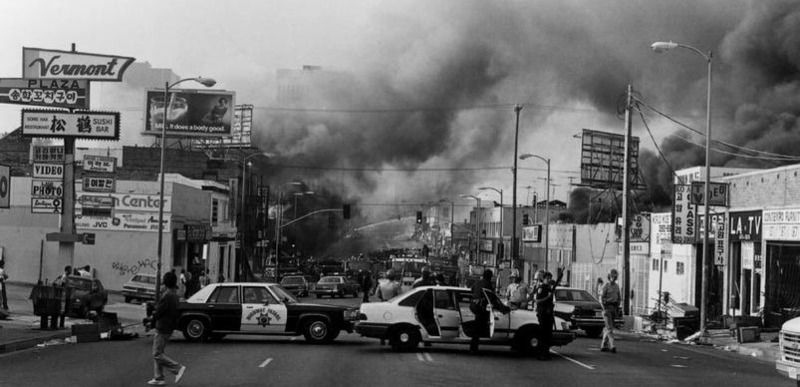
A photograph capturing the sad chaos of the 1992 L.A. Riots. Author unknown. Used under a Creative Commons license.
Here are five pieces of information about the L.A. Riots. Truth be told, one is a trivial fact and the four other pieces of information attempt to explain the underlying problems that lead to the riots.
Before going forward it is extraordinarily important to note that The L.A. Riots was probably the most important event in modern Southern California history, for many profound reasons. Thus, we do not wish to trivialize this event into a simple Internet listicle, but hopefully this can be used as a jumping off point for further reading, research and understanding issues in L.A. and Southern California's past and present, and will maybe give perspective on events happening in Baltimore and Ferguson, Missouri.
1 - Is The Official Name of the Unrest Called "The L.A. Riots"?
There has been many different suggestions on just what those days in 1992 should be called. Some people and groups have called the civil unrest, "The L.A. Rebellion," "The Uprising," "The 1992 Riots," "The Rodney King Riots," or "Days of Rage," among other names. The name commonly accepted when talking about this riot is simply, "The L.A. Riots." There was never an official name given to this civil unrest.
2 - Massive Loss of Jobs
As is the case in Baltimore and Ferguson, there is more to what caused the riots than just one event, and often the major factor is the lack of jobs, or in the case of L.A. and Baltimore, good-paying industry jobs that vanished. In the postwar years in L.A. and Southern California many African-Americans were employed with good-paying jobs in and along the Alameda Corridor/Long Beach Freeway (I-710) industrial section. Outside of Detroit in Southern California, most of it located along the I-710, the automobile industry and its feeder industries, was a major employer for African-Americans. There were also other major factory industries, like Bethlehem Steel in Vernon
Regrettable many African-Americans faced discrimination in these industries, but in time many were able to obtain good-paying union jobs. One place African-Americans did not face discrimination was in the tire-making industry. Mostly located in Commerce the major tire-makers had huge factories, and, in fact, "The Citadel" outlet shopping center was once the Uniroyal factory. Many African-Americans were able to obtain very high-paying jobs in these rubber factories.
In the name of Cold War defense and "the space race," the aerospace and defense industries rapidly expanded in Southern California, but discrimination found its way in this high-paying prestigious industry as many African-American males were turned down for jobs. However, for African-American females it was a different story, because many of the aerospace firms hired African-American females for high-paying clerk positions.
It really cannot be overstated enough that the steel, manufacturing, auto, rubber, defense and aerospace industries were extraordinarily major employers in Los Angeles County, and at their height they were bigger employers than the entertainment industry.
3 - Why Did These Industries Leave L.A. County?
The short answer, outsourcing and the end of The Cold War. In the late 1980s and early 90s it seemed weekly there were news reports of aerospace and defense industries laying off hundreds of people as The Cold War was coming to an end and The Soviet Union dissolved.
As for the factories in the cities along the I-710, well, the outsourcing, laying off and subsequent closing of the many various factories started in the mid-1970s and just went downhill from there.
With these jobs leaving many African-Americans, along with many other people of all races, were out of a job and there were not many other jobs available for the skills they honed over the decades working at these places in the industry corridor.
4 - Housing Discrimination
Going back to the post-war years when these industries were paying very good wages to African-Americans many African-Americans, just like everybody else, wanted the suburban life Southern California was quickly becoming famous for, but discrimination made it very difficult. Discrimination in this case, unfortunately, came by way of housing covenants, which made selling homes to African-Americans quasi-illegal.
It took one homeowner in Sugar Hill near West Adams who was being harassed and told they cannot sell their home to an African-American family that brought a case to the courts against housing covenants. Even though the California courts said housing covenants were wrong this case wound its way all the to the United States Supreme Court, and the majority of justices agreed with the California courts and said it was wrong and illegal. Regrettably, in that Supreme Court case those who reveled in these housing covenants found, for lack of a better word, "a loophole" in the ruling and it would take another Supreme Court ruling to totally outlaw housing covenants.
Even the high court's ruling did not stop the practice of housing discrimination for many years. Real estate agents and organizations colluded to prevent African-Americans from buying homes in places like the San Fernando Valley and Lakewood.
Interestingly enough, during the 1950s and 60s when Caucasians lived in South-Central L.A. there was resistance to sell homes to Africa-Americans. In fact, there were several cases in 1950s South-Central L.A. of African-Americans being harassed, crosses burned on their lawns, and in one case, a bomb being set-off at an African-American home (following that bombing several new African-American residents of South-Central received death threats).
5 - Why Were Korean Stores Targeted?
In the 1992 riots Mayor Tom Bradley's office estimating that 65 percent of all businesses vandalized were Korean-owned. Why? Well, there had been long simmering tensions between the African-American community and Korean store owners. Some of this was just cultural misunderstanding, and, according to various community leaders, Korean business owners came into many poor neighborhoods where supermarkets or other stores were not easily available and were overcharging for items.
The tipping point in Korean-African American relations was the shooting death of Latasha Harlins by Korean store owner Soon Ja Du on March 16, 1991, at Ms. Du's liquor store, Empire Liquor, which was caught on the store's security video camera.
Ms. Du observed Ms. Harlins putting a bottle of orange juice in her backpack and Ms. Du thought Mr. Harlins was going to shoplift, and evidently did not see the $2 dollars Harlins held in her hand to pay for the orange juice. Seeing this and thinking a shoplifting was about to take place Ms. Du grabbed Ms. Harlins by the sweater and snatched her backpack, and then Ms. Harlins struck Ms. Du with her fist three times, knocking Ms. Du to the ground. As Ms. Harlins backed away Ms. Du then threw a stool at her, and Ms. Harlins picked up the orange juice that was dropped during the scuffle, threw it on the counter and turned to leave. It was at that point Ms. Du retrieve a handgun firing at Ms. Harlins, shooting her in the back of her head, killing her instantly.
In November 1991, a jury at the L.A. County Superior Court in Compton found Ms. Du guilty of voluntary manslaughter, which carries a maximum prison sentence of 16-years. However, in a decision that would further inflame tensions between the Korean community and African-American community, Judge Joyce Karlin sentenced Ms. Du to five years of probation, four hundred hours of community service, and a $500 fine.
Around the same time there was a Glendale man who was sentenced to prison time for abusing animals, which lead many people to say that, "A dog's life is more valuable than a African-American girl's life."
Community leaders, city officials and scholars, among other people, have said the civil unrest that exploded on April 29, 1992, was a catalyst for Korean and African-American tensions erupting and why many Korean businesses were targeted.
Ms. Du's store was destroyed by fire during the riots.

A photograph capturing the sad chaos of the 1992 L.A. Riots. Author unknown. Used under a Creative Commons license.
Here are five pieces of information about the L.A. Riots. Truth be told, one is a trivial fact and the four other pieces of information attempt to explain the underlying problems that lead to the riots.
Before going forward it is extraordinarily important to note that The L.A. Riots was probably the most important event in modern Southern California history, for many profound reasons. Thus, we do not wish to trivialize this event into a simple Internet listicle, but hopefully this can be used as a jumping off point for further reading, research and understanding issues in L.A. and Southern California's past and present, and will maybe give perspective on events happening in Baltimore and Ferguson, Missouri.
1 - Is The Official Name of the Unrest Called "The L.A. Riots"?
There has been many different suggestions on just what those days in 1992 should be called. Some people and groups have called the civil unrest, "The L.A. Rebellion," "The Uprising," "The 1992 Riots," "The Rodney King Riots," or "Days of Rage," among other names. The name commonly accepted when talking about this riot is simply, "The L.A. Riots." There was never an official name given to this civil unrest.
2 - Massive Loss of Jobs
As is the case in Baltimore and Ferguson, there is more to what caused the riots than just one event, and often the major factor is the lack of jobs, or in the case of L.A. and Baltimore, good-paying industry jobs that vanished. In the postwar years in L.A. and Southern California many African-Americans were employed with good-paying jobs in and along the Alameda Corridor/Long Beach Freeway (I-710) industrial section. Outside of Detroit in Southern California, most of it located along the I-710, the automobile industry and its feeder industries, was a major employer for African-Americans. There were also other major factory industries, like Bethlehem Steel in Vernon
Regrettable many African-Americans faced discrimination in these industries, but in time many were able to obtain good-paying union jobs. One place African-Americans did not face discrimination was in the tire-making industry. Mostly located in Commerce the major tire-makers had huge factories, and, in fact, "The Citadel" outlet shopping center was once the Uniroyal factory. Many African-Americans were able to obtain very high-paying jobs in these rubber factories.
In the name of Cold War defense and "the space race," the aerospace and defense industries rapidly expanded in Southern California, but discrimination found its way in this high-paying prestigious industry as many African-American males were turned down for jobs. However, for African-American females it was a different story, because many of the aerospace firms hired African-American females for high-paying clerk positions.
It really cannot be overstated enough that the steel, manufacturing, auto, rubber, defense and aerospace industries were extraordinarily major employers in Los Angeles County, and at their height they were bigger employers than the entertainment industry.
3 - Why Did These Industries Leave L.A. County?
The short answer, outsourcing and the end of The Cold War. In the late 1980s and early 90s it seemed weekly there were news reports of aerospace and defense industries laying off hundreds of people as The Cold War was coming to an end and The Soviet Union dissolved.
As for the factories in the cities along the I-710, well, the outsourcing, laying off and subsequent closing of the many various factories started in the mid-1970s and just went downhill from there.
With these jobs leaving many African-Americans, along with many other people of all races, were out of a job and there were not many other jobs available for the skills they honed over the decades working at these places in the industry corridor.
4 - Housing Discrimination
Going back to the post-war years when these industries were paying very good wages to African-Americans many African-Americans, just like everybody else, wanted the suburban life Southern California was quickly becoming famous for, but discrimination made it very difficult. Discrimination in this case, unfortunately, came by way of housing covenants, which made selling homes to African-Americans quasi-illegal.
It took one homeowner in Sugar Hill near West Adams who was being harassed and told they cannot sell their home to an African-American family that brought a case to the courts against housing covenants. Even though the California courts said housing covenants were wrong this case wound its way all the to the United States Supreme Court, and the majority of justices agreed with the California courts and said it was wrong and illegal. Regrettably, in that Supreme Court case those who reveled in these housing covenants found, for lack of a better word, "a loophole" in the ruling and it would take another Supreme Court ruling to totally outlaw housing covenants.
Even the high court's ruling did not stop the practice of housing discrimination for many years. Real estate agents and organizations colluded to prevent African-Americans from buying homes in places like the San Fernando Valley and Lakewood.
Interestingly enough, during the 1950s and 60s when Caucasians lived in South-Central L.A. there was resistance to sell homes to Africa-Americans. In fact, there were several cases in 1950s South-Central L.A. of African-Americans being harassed, crosses burned on their lawns, and in one case, a bomb being set-off at an African-American home (following that bombing several new African-American residents of South-Central received death threats).
5 - Why Were Korean Stores Targeted?
In the 1992 riots Mayor Tom Bradley's office estimating that 65 percent of all businesses vandalized were Korean-owned. Why? Well, there had been long simmering tensions between the African-American community and Korean store owners. Some of this was just cultural misunderstanding, and, according to various community leaders, Korean business owners came into many poor neighborhoods where supermarkets or other stores were not easily available and were overcharging for items.
The tipping point in Korean-African American relations was the shooting death of Latasha Harlins by Korean store owner Soon Ja Du on March 16, 1991, at Ms. Du's liquor store, Empire Liquor, which was caught on the store's security video camera.
Ms. Du observed Ms. Harlins putting a bottle of orange juice in her backpack and Ms. Du thought Mr. Harlins was going to shoplift, and evidently did not see the $2 dollars Harlins held in her hand to pay for the orange juice. Seeing this and thinking a shoplifting was about to take place Ms. Du grabbed Ms. Harlins by the sweater and snatched her backpack, and then Ms. Harlins struck Ms. Du with her fist three times, knocking Ms. Du to the ground. As Ms. Harlins backed away Ms. Du then threw a stool at her, and Ms. Harlins picked up the orange juice that was dropped during the scuffle, threw it on the counter and turned to leave. It was at that point Ms. Du retrieve a handgun firing at Ms. Harlins, shooting her in the back of her head, killing her instantly.
In November 1991, a jury at the L.A. County Superior Court in Compton found Ms. Du guilty of voluntary manslaughter, which carries a maximum prison sentence of 16-years. However, in a decision that would further inflame tensions between the Korean community and African-American community, Judge Joyce Karlin sentenced Ms. Du to five years of probation, four hundred hours of community service, and a $500 fine.
Around the same time there was a Glendale man who was sentenced to prison time for abusing animals, which lead many people to say that, "A dog's life is more valuable than a African-American girl's life."
Community leaders, city officials and scholars, among other people, have said the civil unrest that exploded on April 29, 1992, was a catalyst for Korean and African-American tensions erupting and why many Korean businesses were targeted.
Ms. Du's store was destroyed by fire during the riots.

